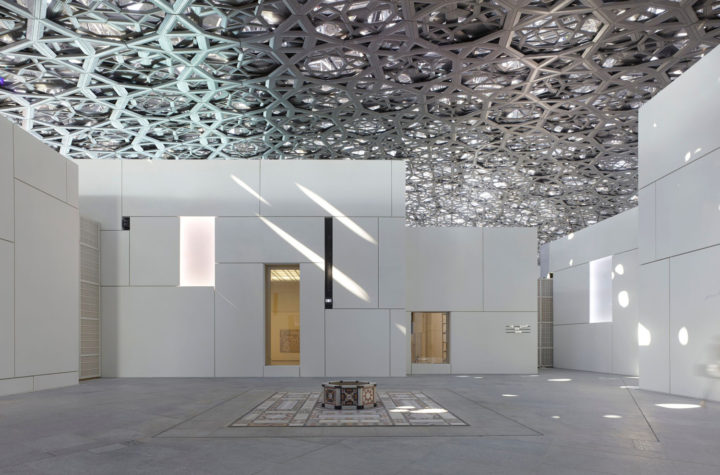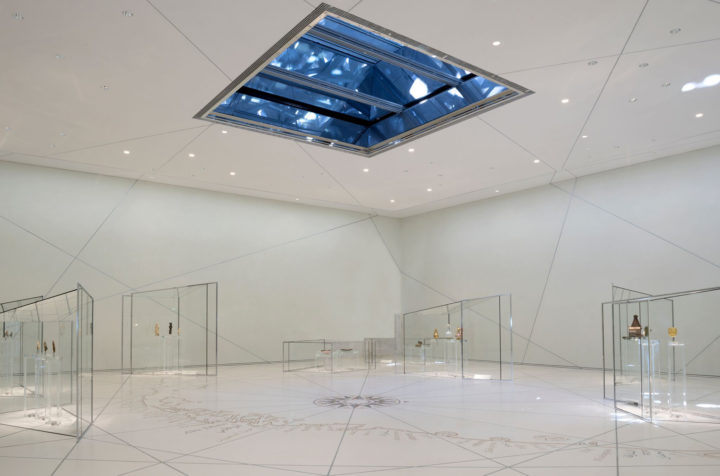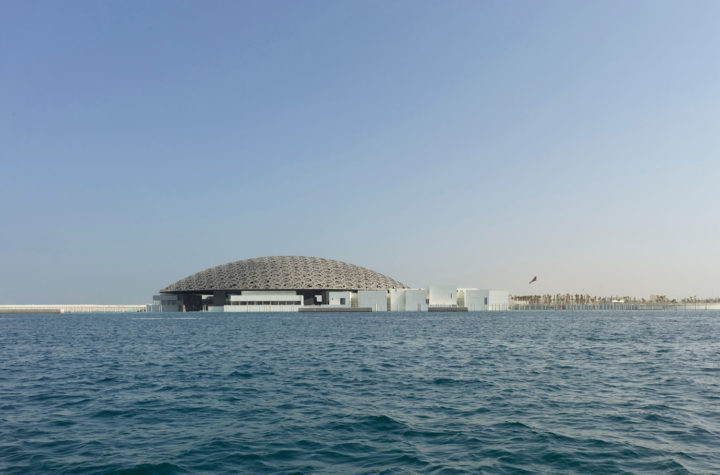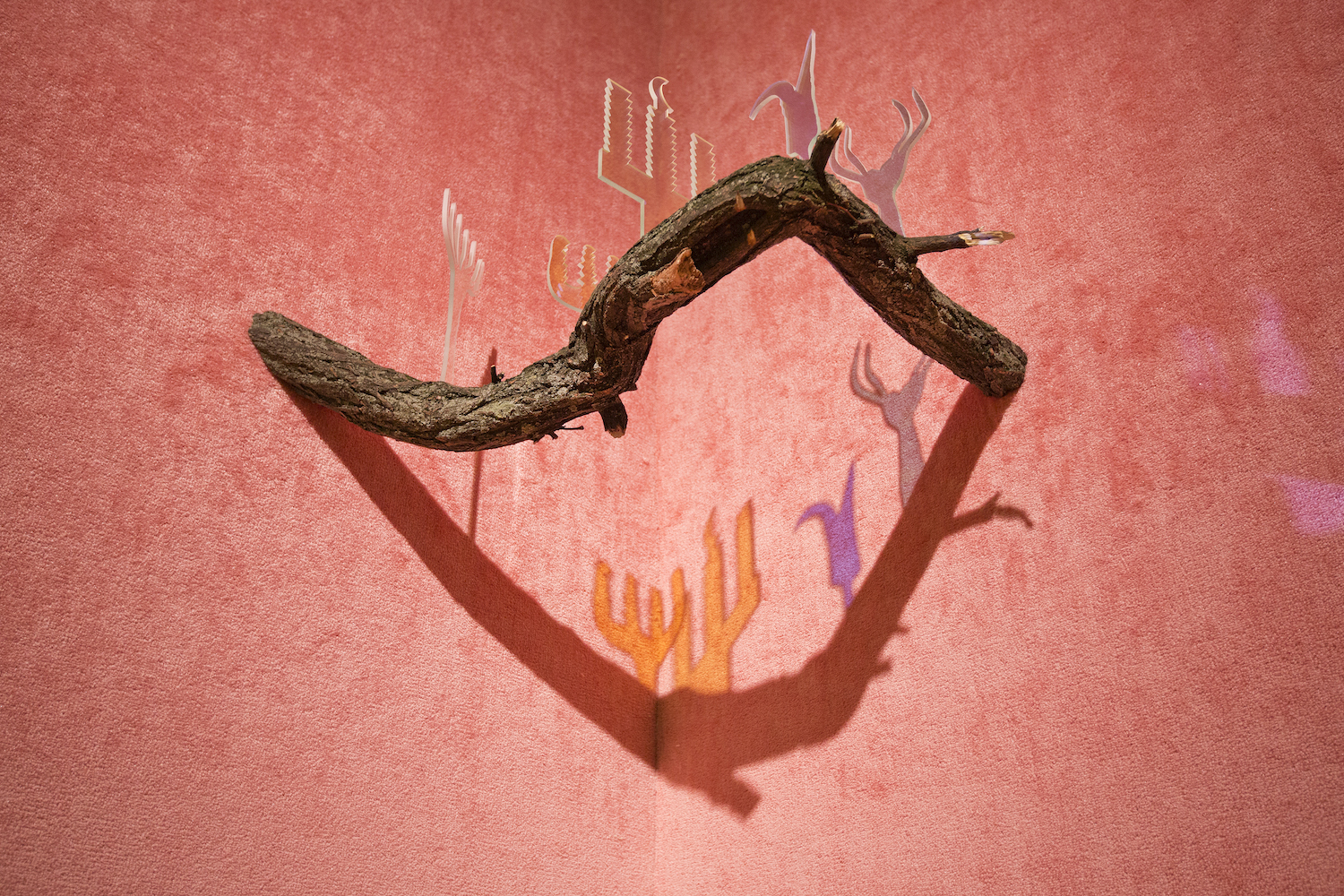Long heralded, regularly maligned and largely misunderstood, the Louvre Abu Dhabi finally opened its doors to the public on November 11, 2017. Nestled on the shores of Saadiyat (Happiness) Island in the United Arab Emirates’ capital city, the fledgling institution is the first of a bevy of starchitect-built museums that will, one day, dot this luxury tourism/cultural island destination.
For the moment, though, Jean Nouvel’s “city within the city” stands supreme, its latticed mashrabiya-like dome crouched practically to the level of the Gulf waters, which lap away at the blazing white buildings splayed below the vaulted 180-meter-diameter disc. As the broiling sun sifts through the emblematic dome (the museum’s logo is in fact abstracted in the canopy’s porous intricacies), the open-air passages and mini-agoras are dappled with what the Pritzker Prize-winning architect calls, rather prosaically, a “rain of light.” The building deftly sidesteps the predictable pastiches of arabesque motifs, the tiresome tropes of medina-as-warren. It seems of here, yet not from here: it is a re-creation of a local visual patrimony, rather than a reproduction of one. Everyone agrees: it is a wonder.
Step inside, however, and opinions start to divide. The Louvre Abu Dhabi is touted as the first “universalist” museum of the twenty-first century, and certainly the only one of its ilk in the Arab world. Universalism, in the minds of the Louvre Abu Dhabi’s reigning regents, stands in contrast to the encyclopedic ethos that has driven the monstres sacrés of the West, the Musée du Louvre on the banks of the Seine and London’s British Museum being the standard bearers of the genre. Where encyclopedism is in-depth, exhaustive, specialized and, ultimately, compartmentalized (think of the Paris Louvre’s physical split into departments), universalism is a cultural mix. Its vocation is to connect diverse works (archaeological, decorative, “fine art”) to an extremely long timespan across world cultures. A walk through its galleries is an encounter with a sort of manifold universal memory. A twelfth-century lion sculpture from Muslim-ruled Spain “dialogues” with a Chinese dragon sculpture of the same era that had meandered into the collection of the Stoclet Palace in Brussels (provenance is critical for the Louvre Abu Dhabi); a red sandstone Buddha head from Northern India in the fifth century is paired with a white marble Qi dynasty Buddha bust from nearly the same time; Marcel Duchamp’s Porte-bouteilles (1913) rubs shoulders with a wood and metal “magic statue” from the Batsangui culture in Gabon (1900–30), the readymade-meets-totem ricochet conjuring all manner of questions.
Simply put, this is the story of mankind — from the first settlements through the rise of world religions and trade routes, to the princely court, modernism and our contemporary moment. The vicissitudes of this saga are told through the museum’s own burgeoning collection, the fruit of an acquisition spree that began in 2009 with the purchase of Mondrian’s Composition with Blue, Red, Yellow and Black (1922) from the Yves Saint-Laurent/Pierre Bergé estate (provenance, again). The works now total around 650. Complementing this bedrock are some three hundred pieces on loan from the consortium of French lending institutions known as Agence France-Muséums, created at the time of the intergovernmental accord between France and the UAE that sealed the deal in 2007, granting the Emiratis use of the Louvre name for thirty years (only twenty remain).
Local intelligentsia, while smitten by the sudden array of treasures permanently displayed at arm’s reach, remain skeptical: has the Louvre Abu Dhabi decentralized the implicit Western-centric cultural viewpoint as successfully as it has dismantled the rigid encyclopedic methodology, itself the fruit of Enlightenment idealism and imperial opportunism? While some works on loan from the Musée Guimet and the Musée de la Quai Branly (providing Oriental and Asian, African and Oceanic artworks, respectively) amplify the Global South feel, critics bemoan an underrepresentation of Arab modernists, manifested by a token Saloua Raouda Choucair sculpture.
Alongside this threadbare modernism is a willful nationalist narrative. As expected, we find the soft power innuendo that frames the country as a tolerant, enlightened, cultural bridge-builder: the side-by-side Quran-Bible-Torah display; instances of nudity (Bellini’s 1480–85 Madonna and Child, bronze dancers by Degas) nimbly foiling foreign journalists’ finger-pointing to puritanism and censorship.
The UAE seems to have taken the opportunity of the universalist vitrine to write itself, meaningfully, into global history. Neolithic pottery hailing from Mesopotamia yet unearthed on nearby Marawah Island, for example, lends credence both to the land’s ancientness and its role as a fulcrum of early maritime trade. Emirati artist Abdullah al-Saadi gets pride of place, as his Naked Sweet Potato (2000–10) sculpture and single-channel video are the final pieces in the contemporary gallery. Even Giuseppe Penone’s commissioned work, Germination (2016), a single line spiraling across Sèvres-manufactured porcelain tiles, holds at its center the thumbprint of Sheikh Zayed bin Sultan al-Nahyan, founding father of the nation.
Jenny Holzer’s monumental texts, another commission with a mission, seem carved into the very flesh of the building, as if they had somehow always been there. They include a creation myth written in Acadian and Sumerian, an excerpt on self-determination from sixteenth-century philosopher Michel de Montaigne’s Essais, and a passage from thirteenth-century Arab philosopher Ibn Khaldun’s Muqaddimah, which neatly casts the universalist conceit as homegrown.
For such a young museum, the Louvre Abu Dhabi already has a rocky history: accusations of laborer exploitation, a succession of false-alarm opening dates, and persistently fuzzy local understanding of its affiliation to the Louvre mère. To be clear: this is an autonomous Emirati institution. It is not an off-the-shelf franchise deal, nor is it the by-product of the Paris Louvre sniffing out juicy emerging markets. Agence France-Muséums will not only spearhead temporary exhibitions, it is contractually bound to lend an average of three hundred works per year until 2026, regularly rotated. The Louvre Abu Dhabi relies on the technical, curatorial and educative guidance of its French partners but, at one point, it should attain self-sufficiency. After all, in only twenty years, the right to the Louvre name will vanish.
What that self-sufficiency might look like is hard to imagine today. The stakeholders believe hard and fast in education. So much so, they have even concocted a “Children’s Museum” — a museum-in-the-museum with actual artworks displayed at kid’s-eye level and mediators galore. But after the euphoria of opening week settles, the hard work of promotion begins, with one burning question: How do we keep people coming back?






